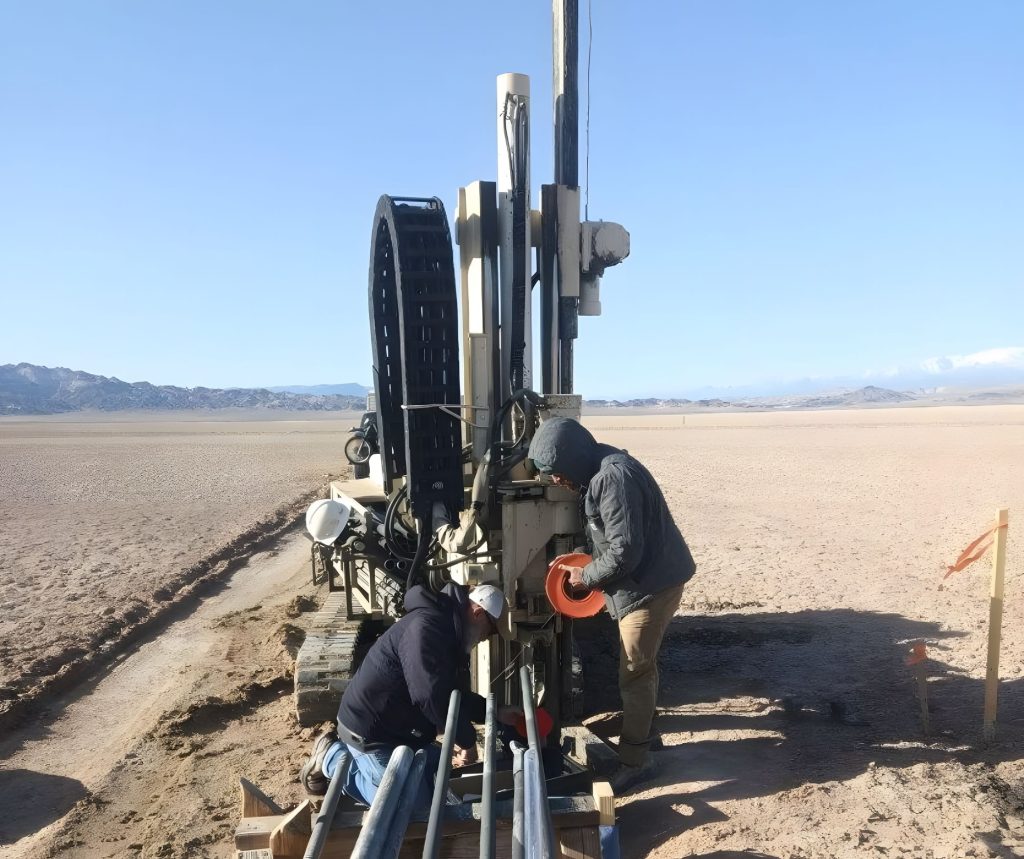Canter Resources drills boron and lithium at Columbus, Nevada

Canter Resources Corp. [CSE-CRC; OTC-CNRCF; FSE-601] reported initial brine and clay/sediment assay results from the company’s completed 15-hole phase I shallow Geoprobe drill program at its Columbus lithium-boron project near Tonopah, Nevada. The assays reported herein correspond to approximately 35% of the samples collected during the program.
Initial results successfully demonstrated mineralized brines from shallow aquifers over 2 km in strike highlighting the potential for multilayered aquifers at Columbus.
The initial sediment/clay samples returned peak values of 3,070 parts per million boron (B), 690 ppm lithium (Li) and 3.89 per cent potassium (K) with several highly mineralized sedimentary intervals starting from surface. Clay results from CB24-018/019 highlight potential for higher-grade Li-B mineralization to extend for km to the west.
Brine assay results returned notably significant boron values up to 508 milligrams per litre (mg/L), along with anomalous Li values up to 49.8 mg/L and high K values up to 5,870 mg/L.
“We are excited to see these boron-enriched brine concentrations and significant sedimentary intervals within the first approximately 30 metres along an extended strike length at Columbus,” stated Joness Lang, CEO. “Seeing boron-enriched brines and lithium-enriched clays in this shallow interval provides further proof of concept, supports our ongoing targeting and speaks to the multicommodity potential at Columbus. Boron production is currently limited to a few regions and operators globally and with boron applications rapidly advancing across our most critical growth sectors, including semiconductors and EVs, we view the potential to define significant boron mineralization, domestically, as a tremendous opportunity. We are just getting started with our phased drilling approach and look forward to more results from phase I before probing deeper in subsequent campaigns set to commence in early Q3 2024.”
Highlighted brine results (total values): CB24-012G: 454 mg/L B, 43.5 mg/L Li and 5,870 mg/L K at 17.37 m depth; CB24-011G: 446 mg/L B, 41.2 mg/L Li and 5,030 mg/L K at 12.19 m depth; CB24-012Gx: 468 mg/L B, 15.3 mg/L Li and 4,410 mg/L K at 19.05 m depth; CB24-011Gx: 508 mg/L B, 2.8 mg/L Li and 4,110 mg/L K at 0.82 m depth; and CB24-013G: 337 mg/L B, 49.8 mg/L Li and 5,630 mg/L K at 14.63 m depth.
Highlighted clay assay results (assays rounded): CB24-002G: 1,248 ppm B, 440 ppm Li and 2.7% K average over 25.15 m from surface, including 1,441 ppm B and 583 ppm Li over 13.0 m (up to 2,560 ppm B/690 ppm Li).
CB24-019G: 966 ppm B, 525 ppm Li and 3.4 per cent K over 7.6 m (up to 1,530 ppm B/630 ppm Li); CB24-018G: 2,106 ppm B and 343 ppm Li over final 4.3 m (up to 3,070 ppm B/430 ppm Li); CB24-012G: 1,042 ppm B, 403 ppm Li and 2.66% K over seven m (up to 1,920 ppm B/580 ppm Li).
Initial observations and interpretation of results: A total of 15 shallow drill holes were completed to test the interpreted upper brine generation layer of the basin. The initial five drill holes (400 m spaced north-south grid) consistently intersected aquifers, capturing saturated brines at shallow depths over 2 km, returning significant near-surface boron-enriched brines and lithium-enriched clays, collectively providing support for the company’s deeper brine targeting.
The initial findings from the shallow drilling campaign highlight not only the substantial boron and lithium values, but also reveal the significant role of potassium and barium in influencing the geochemical environment. The company views the potassium concentrations – as high as 5% in these assays – as playing a crucial role in maintaining lithium in solution due to ion exchange processes.
Anomalous boron values near surface are a commonly used pathfinder for targeting significant lithium concentrations deeper in a mineralized system, but the Company views the consistently elevated boron values in shallow brines and clays as very significant on a standalone basis. Boron brine concentrations ranged from 315 mg/L to 508 mg/L and averaged 417 mg/L across the initial brine results. Boron values (and total dissolved solids – TDS) also increased with depth.
Canter Resources is advancing the Columbus Lithium-Boron Project in Nevada, USA and the Beaver Creek Lithium Property in Montana, USA. The company is completing a phased drilling approach at Columbus to test highly prospective brine targets at varying depths for lithium-boron enrichment and plans to leverage the company’s critical metals targeting database to generate a portfolio of high-quality projects.
